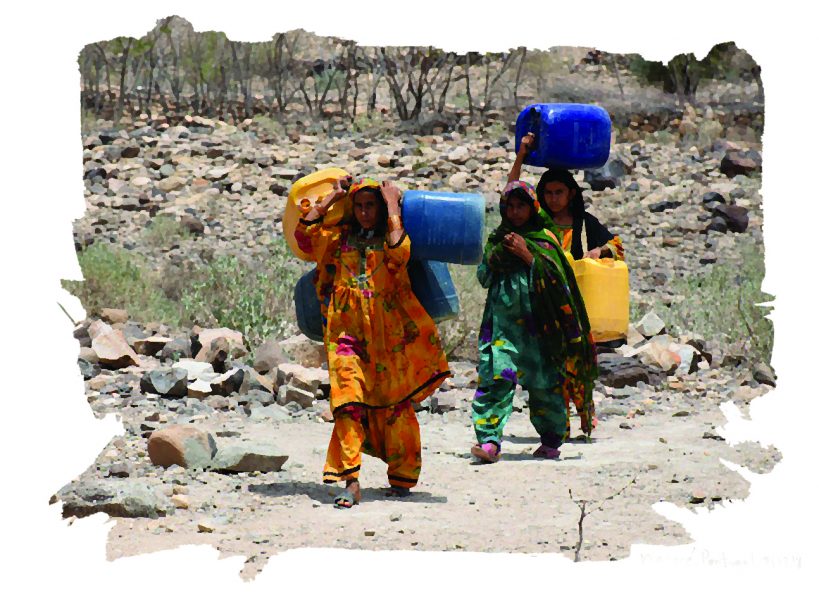Almost all districts of the province have a chronic shortage of clean drinking water
Balochistan, the largest and most sparsely populated province, is also the least water-secure province of the country. The entire province suffers from a water crisis with around 85% of its 12.3 million people not having access to clean drinking water.
According to an Asian Development Bank (ADB) report from the year 2018, Balochistan is the most at risk from climate change, and the least able to cope with water-related development challenges.
It has 18 river basins and its water resources comprise groundwater (4%); share from the Indus Basin (39%) and floodwater (57%).
Agriculture accounts for 93% of the total water use in Balochistan. The mean annual precipitation – rain, snow, sleet, or hail that falls to or condenses on the ground – in the province is 50–350 millimeters. “Water availability per hectare per year is about 560 cubic meters in Balochistan, much lower than the average of 2,500 cubic meters in Pakistan’s other provinces,” said the report.
According to a 2018 study undertaken by researchers from the Balochistan University of Information Technology, Engineering and Management Sciences (BUITEMS), Quetta – the provincial capital of Balochistan – is also running out of water
It said the main reasons for water scarcity in the city is rising population growth, the growth of high delta crops, low rainfall and over-exploitation of groundwater.
The study said installation of new tube-wells, violation of tube-wells spacing norms and subsidy on electric tube-wells were also key factors that led to the water shortage in Quetta district. “Moreover, the results also showed that most of the farmers are not aware of the modern high-efficiency irrigation system [and this lack of knowledge has] led to mismanagement of water resources.”
The study said this water shortage has adversely affected the social and economic condition as well as health of farmers; caused migration of farmers from their native places and resulted in conflicts among farmers.
Gwadar, a key node in the multi-billion dollar China-Pakistan Economic Corridor (CPEC), is also severely affected by a scarcity of water, prompting its citizens to take to streets. A report said this crisis is bound to get worse as Gwadar’s annual population growth rate of nearly 3 percent is expected to increase manifold once port companies start hiring. The government has not yet not found a sustainable solution to the water issue. Presently, tanker companies truck in water from Mirani Dam which is located some 150 kilometers away from Gwadar. Hauling water from such a far place increases the cost of water manifold.
This tanker-mafia has benefited enormously from the water shortage. The contractors repeatedly stop supplying water over payment disputes and practically hold the citizens of Gwadar hostage.
The ADB report also linked the poverty in the province to this water scarcity. It said the depth of poverty runs very high in Pakistan while poverty in Balochistan is a rural phenomenon related to development constraints on the agriculture sector.
“Limited water resources, lack of off-farm employment opportunities, extreme weather conditions, and inefficient and highly unequal use of land and water resources are the main factors contributing to the high poverty levels in the province.” The ADB report stated that the poor population in Balochistan increased from 1.5 million in 1948−1949 to 2.1 million in 2004−2005.
“In 2015, an estimated 71.2% of Balochistan’s population lived below the official poverty line, compared with 38.8% for Pakistan as a whole, as estimated by the United Nations Development Programme using the Multidimensional Poverty Index and reported by the Pakistan Economic Survey (2015–16).”
Some recent news reports showed that this scarcity of water has compelled people of a number of areas to rely on unsafe water from ponds and this situation is causing various diseases including hepatitis. A report claimed that 10,000 patients were diagnosed with hepatitis C and B during the first six months of 2021. It said a total of 3,000 patients were reported in the Jaffarabad district while 1,000 people were diagnosed with hepatitis in Lasbela district during a mass screening. In order to prevent growing hepatitis and stomach diseases in Balochistan, the citizens must be provided clean drinking water. However, the federal and provincial governments’ previous efforts to install reverse osmosis and filtration plants in different areas have not helped much.
In 2005, the federal government installed 100 filtration plants across Balochistan. The federal government had later started the “Clean Drinking Water for All” project in 2007. The government had decided to install 409 filtration plants in the province at a cost of Rs750 million. However, this project later became mired in corruption.



















